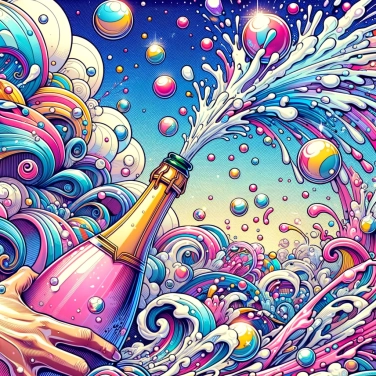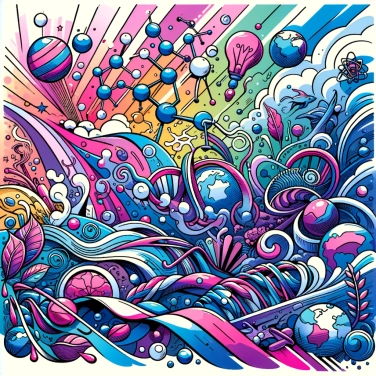When a bottle of champagne is opened, the carbon dioxide dissolved in the liquid is released in the form of bubbles due to the sudden drop in atmospheric pressure that occurs in the neck of the bottle.

Carbon dioxide (CO₂) is a gas that manufacturers deliberately add to champagne during its production: it is what gives it its sparkling quality. During fermentation, yeast converts sugar into alcohol and produces CO₂ in the process. This gas completely dissolves in the liquid because the bottle is hermetically sealed, allowing for high pressure inside. The CO₂ remains calm, trapped in the liquid as long as this pressure is kept high. As soon as the bottle is opened, the pressure drops abruptly, releasing all the previously dissolved gas, creating the famous small bubbles that are so appreciated.
In a sealed bottle of champagne, the gas (carbon dioxide) is under pressure, dissolved in the liquid. When you open the bottle, the pressure inside drops sharply. This rapid decrease pushes the dissolved gas to escape quickly in the form of small bubbles. The greater the pressure difference between the inside and outside of the bottle, the more vigorous the release of gas, which causes the famous "pop" associated with opening champagne.
Nucleation is simply the stage where small bubbles start to appear in champagne. For this to happen, dissolved carbon dioxide molecules cluster around tiny attachment points called nucleation sites. These sites are often micro-impurities, dust, or small defects on the surface of the glass or residues in the liquid itself. Once attached to these imperfections, carbon dioxide molecules group together into clusters large enough to form a small bubble visible to the naked eye. From there, these tiny bubbles grow by attracting more dissolved gas towards them, then rise to the surface of the champagne to pop pleasantly under your nose.
The glass of the bottle or your champagne flute is never completely smooth or perfect, even if it looks like it. It always contains small defects like scratches, dust, or tiny rough spots. It is in these precise places, these points of attachment, that the dissolved gas will take the opportunity to form its first bubbles: this is what we call nucleation sites. Without these small imperfections, bubble formation would be complicated, making the champagne less sparkling. The more slight roughness the glass has, the richer your drink will be in fine, active, and regular bubbles, directly contributing to the perceived quality of the champagne. Some flutes even intentionally have small engravings at the bottom to ensure a nice, steady stream of bubbles.
The temperature has a direct effect on bubble formation: the warmer the champagne is, the less gas remains dissolved in it. Thus, if the bottle is not cold enough, the carbon dioxide escapes quickly and the bubbles burst suddenly at the moment of opening. In contrast, well-chilled champagne retains its gas better, resulting in finer bubbles and a gradual, prolonged release.
As for the pressure, it’s simple: as long as the bottle remains closed, the pressure is high, about 6 bars, and keeps a lot of gas dissolved. As soon as the bottle is opened, bam, the pressure suddenly drops to that of the surrounding atmosphere. This shock abruptly releases the CO₂, instantly triggering bubble formation. The greater the difference between the pressure inside and outside, the more spectacular the "pop" effect will be.
The bubbles in champagne accelerate the diffusion of aromas to the nose and mouth, which subtly enhances the taste and aromatic perception during tasting.
Keeping a bottle of champagne chilled before opening significantly reduces the risk of foam explosion upon opening, as the solubility of carbon dioxide increases when the temperature decreases.
A typical bottle of champagne generally contains up to 2 million bubbles. The number and fineness of the bubbles are considered quality criteria during tasting.
The shape and finesse of the glass directly influence the appearance of bubbles. A narrow and elongated champagne flute encourages a slow and steady rise of the bubbles, thereby enhancing the aromatic experience.
The carbon dioxide bubbles rise due to their low density compared to the liquid. They are pushed towards the surface by the buoyant force acting on the gases submerged in the liquids.
Yes, to preserve the fizz for a longer time, it is recommended to use a specific airtight stopper for champagne and to keep the bottle cool. By limiting exposure to warm air and agitation, you delay the escape of carbon dioxide.
Yes, a lower temperature allows for better dissolution of carbon dioxide in champagne. Conversely, warmer champagne releases the gas more quickly, resulting in more bubbles right upon opening.
By slowly opening the bottle while slightly tilting it and maintaining a constant pressure on the cork, you reduce the pressure difference, thereby limiting the rapid expulsion of gas and consequently the excessive amount of foam.
No, it is not directly a proof of quality. However, the fineness, consistency, and elegance of the bubble cord are considered characteristic signs of a more refined, pleasant, and prestigious champagne.
The amount of bubbles mainly depends on the micro-impurities or imperfections on the surface of the glass. These points serve as nucleation sites where the carbon dioxide dissolved in the champagne can easily transform into gas bubbles.

No one has answered this quiz yet, be the first!' :-)
Question 1/5